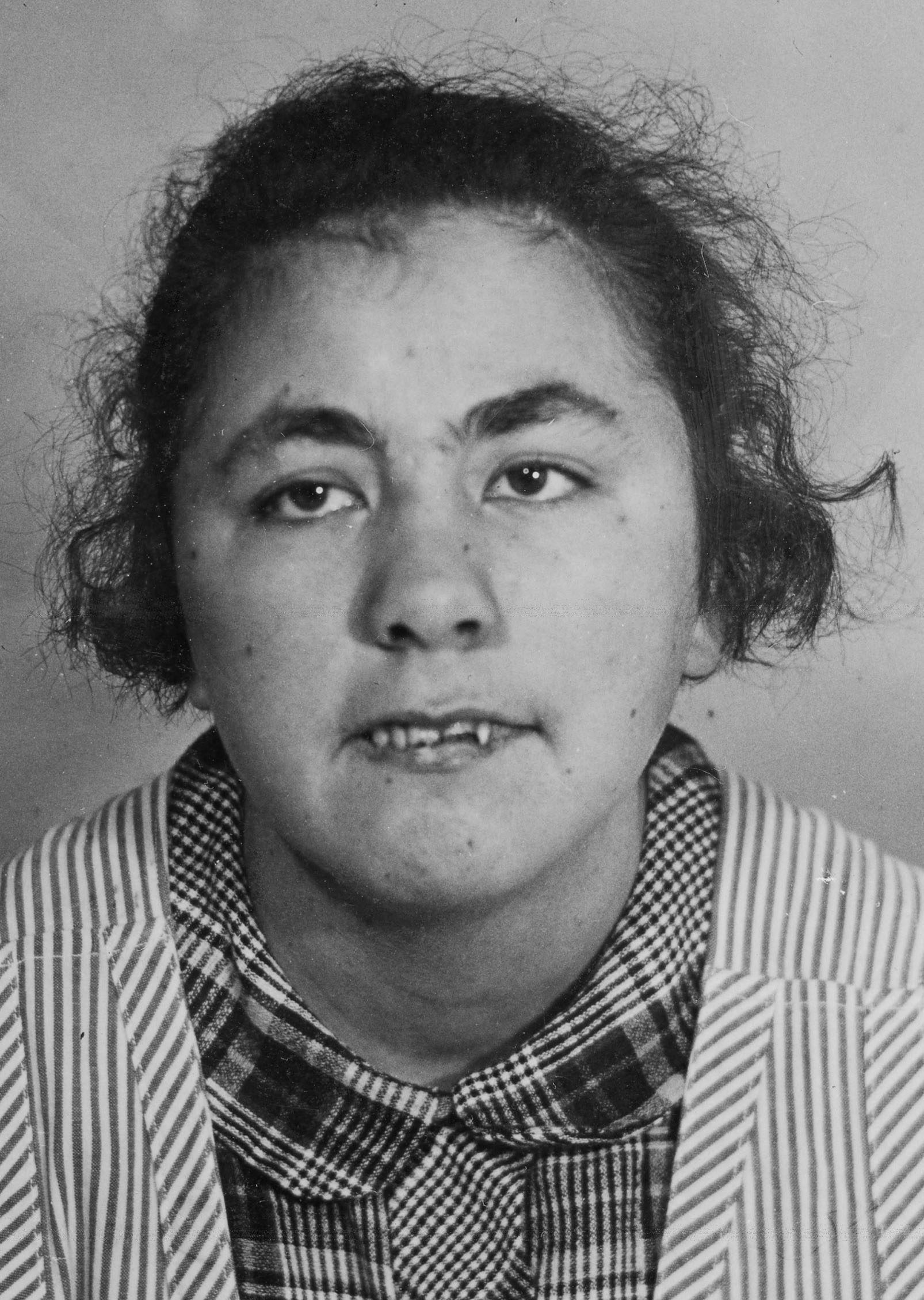Search for Names, Places and Biographies
Already layed Stumbling Stones
Suche
Erna Strüßmann * 1921
Steinwegpassage 1 (Hamburg-Mitte, Neustadt)
HIER WOHNTE
ERNA STRÜSSMANN
JG. 1921
EINGEWIESEN 1943
"HEILANSTALT"
AM STEINHOF WIEN
ERMORDET 3.12.1944
further stumbling stones in Steinwegpassage 1:
Will(y)i Krügel, Mary Mengers
Erna Strüßmann, b. 6.8.1921 in Hamburg, committed to the then Alsterdorf Institute on 4.3.1939, transferred on 8.16.1943 to the Wagner von Jauregg Medical and Nursing Home of the City of Vienna, died 12.3.1944
Steinwegpassage 1
Erna was born in Hamburg, the youngest child of Friedrich Adolf Strüssmann (b. 12.10.1889) and Appolonia, née Przyjemski (b. 2.2.1881). Her parents, married in Hamburg on 28 February 1911, had three other children, two sons and a daughter. A further child, a girl, died during a twin birth in 1915; a son died in 1924, shortly after his birth. The family first lived at Stresowstrasse 103, then at Reginenstrasse 11 in Billwerder Ausschlag (today, Rothenburgsort). Erna’s father, a worker, came from Greste in the County of Lippe and belonged to the Lutheran Church. Erna’s mother, Appolonia Strüssmann, on the other hand, grew up in her very religious Polish Catholic home. Her parents, the carpenter Joseph Przyjemski and Marianne, née Filipowicz, had resettled from Stolpe (today, Słupia) to Hamburg at the end of the 19th century.
When, because of a "confusion syndrome,” Appolonia Strüssmann was committed in June 1928 to the Friedrichsberg State Hospital in Hamburg-Eilbek, Erna was placed temporarily in a Catholic orphanage in Bergedorf. At Easter of 1929, she was accepted at "St.-Vincenzhaus,” an institution founded in 1887 and run by the "Schwestern unser Lieben Frau" [Sisters of Notre Dame], a communal order of the Catholic Church in Cloppenburg.
Meanwhile, her mother had been diagnosed with "schizophrenia” and was taken to the Oberaltenallee Sanitarium in Hamburg-Barmbek. Thus, Erna could not return home. In an extract from the welfare dossier for the Strüssmann family, Erna was characterized a "severely mentally deficient” girl. "The results of instruction up to this time are scarcely noticeable.” At the Peter-Friedrich-Ludwig-Hospital in Oldenburg, at the age of 14, Erna was compulsorily sterilized according to the "Law for the Prevention of Hereditarily Diseased Offspring.”
At the end of 1938, the directors of "St.-Vincenzhauses" attempted to be rid of Erna: "She no longer fits into the framework of our home, because she can no longer go to school; on account of her insufficient mental capacity, it would serve no purpose to assign her to the household group. We do not have a care-giving department, and therefore it would be best to send her to a suitable home.” From a letter sent to the Social Welfare Administration, it can be seen that her father, Adolf Strüssmann, had petitioned for the release of his daughter. His wish to take his daughter home was refused as "wholly impossible.” "She suffers from a high degree of mental disability, has no understanding of dangers, and can in no way be made useful. Were she left alone in the household of her father, she could, out of ignorance, cause the greatest harm, for example, a fire or something of that sort.”
Thus, after lengthy negotiations between "St.-Vincenzhaus" and the Hamburg Social Welfare Administration, Erna went on 3 April 1939 to the then Alsterdorf Institute (today, the Evangelical Alsterdorf Institute). Two months previously, her parents’ marriage was dissolved. Adolf Strüssmann married again on 28 June 1940. He was seriously ill and died a short time later on 11 July 1940.
At Alsterdorf, Erna was initially described as friendly and pleasant, although she became disruptive at night, when, without any obvious reason, she would scream. According to her last evaluation on 15 September 1942, it was stated: "Pat[ient] is unable to care for her body by herself, continually mixes up her shoes. She is a playful child, is always running around with her head bowed. You cannot tell her anything. If she is forbidden something, she constantly says, I will tell my mother, who will make a complaint.”
On 16 August 1943, like other patients, Erna Strüssmann was transferred to Vienna on the standard rationale that the institute had been severely damaged in an air raid. At the Wagner von Jauregg Medical and Nursing Home of the City of Vienna, Erna was described as "disoriented in every respect.” Because of a speech impediment she was regarded as difficult to understand. Three months after her arrival it was noted: "In the day-room, she sits in a corner, starts to scream without cause, and will not answer.” Shortly before her death, she was transferred to the "care ward.” On 20 October 1944, it was noted: "weak, deteriorating, no longer takes nourishment.
Erna Strüßmann died on 3 December 1944. Deliberate neglect, withdrawal of nourishment, and the spread of infectious diseases proved fatal. Erna was said to have died of tuberculosis.
Her mother Appolonia was transferred, on 25 or 26 March 1941, from the sanitarium to the Meseritz-Obrawalde State Mental Hospital in Pomerania. In that place a patient’s chance of survival rested upon his or her ability to work. On that basis, Appolonia Strüssmann had no chance. Deaths resulted from drugs, such as morphine or luminal, administered by caregivers in lethal doses, injected or dissolved and infused. The death certificates gave false dates and causes of death. Appolonia Strüssmann’s time of death was officially documented by the Merseritz-Obrawalde registry office as 29 September 1943.
Translator: Richard Levy
Kindly supported by the Hermann Reemtsma Stiftung, Hamburg.
Stand: June 2020
© Susanne Rosendahl
Quellen: StaH 332-5 Standesämter 3186 u 62/1911; StaH 332-5 Standesämter 735 u 158/1915; StaH 332-5 Standesämter 885 u 343/1924; StaH 332-5 Standesämter 1126 u 1771/1940; Archiv der Evangelischen Stiftung Alsterdorf V 228 Erna Strüßmann; Wunder/Genkel/Jenner: schiefen Ebene; Rönn: Langenhorn im Krieg, in: Böhme/Lohalm (Hrsg.): Wege in den Tod, S. 71.


